Bhuj was founded in 1548 AD by Rao Khengarji I, starting a dynasty of jadeja rulers that ruled over Kachchh for 400 years. And so, the old walled city of Bhuj is the most important town in the area. The place lies at the heart of Kutch and is linked by many roads to the rest of the peninsula.
Places of interest
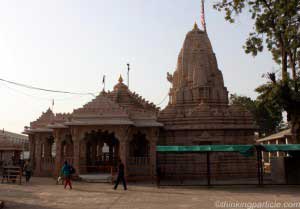
Further west of Kakkadbhit is a temple dedicated to the deity of Jadejas, the erstwhile rulers of Kutch. The original temple, which was demolished in the earthquake of 1819, was believed to be 1200 years old. Sunderji Saudagar built a new temple in its place with unique architectural expositions of dimensions and space. The main structure rises to the height of 52 feet. Navratri is also celebrated here.
At a short distance from Narayan Sarovar & 215 Kms. from Bhuj, the village derives its name from a Shiva temple Kotilingeshwar, housing a self-born ling. It stands as a sentinel on the seashore, rising boldly from the sea that washes its western parts. A fortified wall encloses the temples and the nandi (bull of Shiva) is a fine specimen of Kachchhi art. It is an excellent breathtaking sunset point.
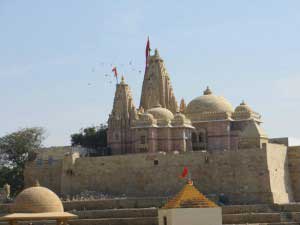
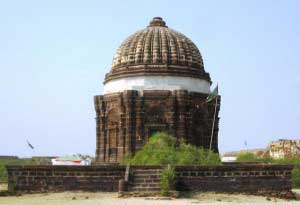
Lakhpat is a trip into history. In this ancient port-city, time has been standing still for ages. It is today deserted, desolate, uninhabited, and invokes powerful nostalgia and soulful affection. Renowned for its beautiful landscape, cenotaphs and memorial stones, the town holds a vantage position due to its westernmost location flanked by the sea and the Rann. Among the few remnants that still enthral the visitors, stand the Gurudwara (holy shrine of the Sikh religion), the 200 year old, gigantic tomb "majhar" of Ghosh Mohammed Caba, and many other places with ancient stories to tell.
One of the most sacred pilgrim centres of the Hindu religion, Narayan Sarovar is uppermost in the pilgrims' circuit. There are actually five sacred lakes here, containing a temple complex is one of its five holy lakes. It finds mention in the ancient scriptures with the other four being Mansarovar at Kailash, Bindusarovar at Bhuvaneshwar, Pushkar in Rajasthan and Pampa in the south. An embankment surrounds the temple complex, which is an assimilation of many hindu divinities, and the architecture, ancient and awesome. A fair is held here on 11th to the 15th of Kartik (November-December).
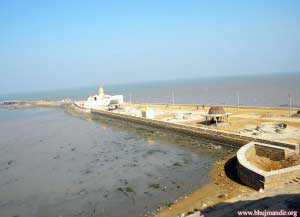
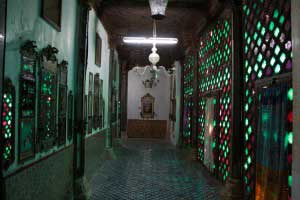
The AINA MAHAL, which now serves as a museum, was built during the rule of Rao Lakhpatji. It now stands as a repository of the culture and history of Kachchh. As referred above, the building bears the influence of its architect Ramsang Malam who was exposed to European style during his long sojourn to Holland.
Rao Lakhpatji died in the mid-18th century and this chhatri was built to honor his memory. The interior is adorned with a stone tablet of the ruler and 15 of his consorts. The exterior walls bear sculptures of deities, hunting scenes, animals and couples in local costumes.


The oldest Museum in Gujarat was established in 1877. It is unique in having the largest collection of Kshatrapa inscriptions, for its gold and silver ornaments, textiles, armoury and other exhibits.
This place is recommended for its rich collection of books and paintings of prominent Kachchhis. On the outskirts of the town is the BHUJIA HILL-FORT, which is still in good condition and has at its top the Temple of Bhujang Naag or serpent, the guardian deity of the city. To the west of the town is HAMIRSAR LAKE, visited by holidaymakers.
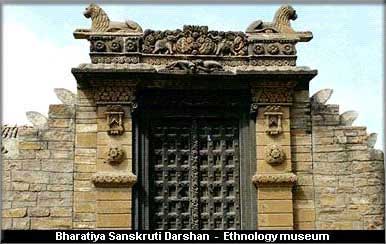
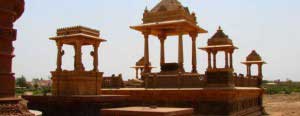
A few kilometers from Punareshwar, Kakkadbhit Yaksha is located along the highway. It is situated on a small hillock with 72 idols of Yaksha or Jakhs, who are believed to have come from Iran. In the opinion of the scholars they were the first batch of Parsi migrants who reached Jakhau due to a shipwreck. The memorial at Kakkadbhit is created in honour of their many acts of sacrifice and bravery on behalf of the local people, against the tyrannical rule of the then ruler Punarvo.
Popularly known for the shrine of Jesal and Toral, the folklore duo wherein the tough outlaw Jesal was chastised by Toral, a Kachchhi woman; is also a centre of fairs. Also the bungalow of James Macmurdo contains remarkable examples of the art of Kutch. The visitors who want to carry home the Kachchhi souvenirs should visit Anjar for its famous block-printing works, nutcrackers, scissors and penknives.

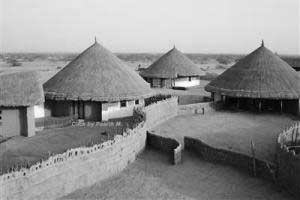
A unique Rabari village, it has about 125 exquisitely designed Kachchhi huts inhabited by about 400 Rabaris. Most of the male population is generally away from the village. The interiors of the huts present a pleasant spectacle of native art. A chat with the womenfolk will introduce visitors to this insulated and pristine culture, a world so different.
It is famous for its rural fair and for the handicrafts, traditional objects, hand-printed and embroidered fabrics, jewellery made and sold there.
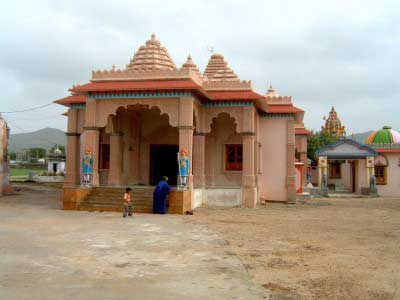
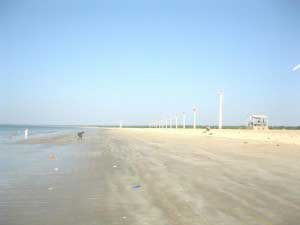
Founded in 1581 AD, it has a fortification with 25 bastions. It was an old and historical port from where extensive trade was done between western India and Africa. The place is a well-known centre for the production of the country crafts. The Rukmavati Bridge built in 1883 is the longest existing one of its kind. The Vijay Vilas Palace evokes the royal splendour of the past. Mandvi's Hawa Mahal is also imposing, and is reminiscent of similar palaces of royal traditions of Rajasthan. Banni and Khavda are villages set like jewels in an expanse of desert. In these villages live some of the most talented craftsmen of Kutch who practise their traditional skills, to produce artistic masterpieces.
The Black Hills of Kachchh are a common geographic feature of the district. The low hills and hillocks lend the beauty and mystique to the rann, which has lured the adventurers through ages. Kalo dungar is the tallest hillock in Kachchh with a shrine dedicated to Lord Dattatreya on the top. A fair is held here on the Janmashtami day every year. Visit to the top of the hill also affords magnificent view of the Rann.
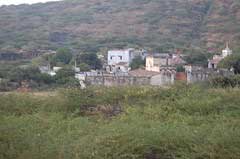

The last village on the border is a Desertland of infinite dimensions, and in its midst, quaint little villages suspended in Time. Here you will come across master craft people' expositioning their traditional art, turning our master pieces everyday. Their ornaments, clothes, utensils, everything they use - will make you feel as if you have stepped into lifestyle museum leaving you spellbound. The Flamingo colony can be approached from Khavda by road and thereafter on camel back.
=>Best time to visit November-April




